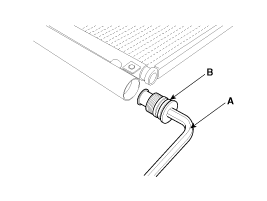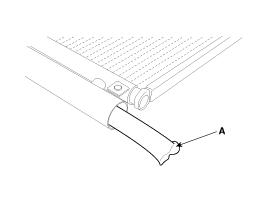Kia Optima Hybrid: Air Conditioning System / Receiver-Drier Repair procedures
| Replacement |
| 1. |
Remove the condenser, and then remove the bottom cap (B) with L wrench (A) from the condenser.
|
| 2. |
Remove the desiccant (A) from condenser using a long nose plier. Check for crumbled desiccant and clogged bottom cap filter.
|
| 3. |
Apply air conditioning compressor oil along the O-rings and threads of the new bottom cap. |
| 4. |
Insert the new desiccant into the receiver drier tank. The
desiccant must be sealed in vacuum before it is exposed to air for use. |
| 5. |
Install the new bottom cap to the condenser.
|
 Condenser Repair procedures
Condenser Repair procedures
Inspection 1. Check the condenser fins for clogging and damage. If clogged, clean them with water, and blow them with compressed air. If bent, gently bend them using a screwdriver or pliers. 2. Check the ...
 Evaporator Temperature Sensor Description and Operation
Evaporator Temperature Sensor Description and Operation
Description The evaporator temperature sensor will detect the evaporator core temperature and interrupt compressor relay power in order to prevent evaporator freezing by excessive cooling ...
Other information:
Kia Optima Hybrid (TF HEV) 2016-2020 Service Manual: Auto Light Switch Repair procedures
Inspection Lighting Switch Inspection With the multi function switch in each position, make sure that continuity exists between the terminals below. If continuity is not as specified, replace the multi-function switch. Lighting Switch (Auto Light) ...
Kia Optima Hybrid (TF HEV) 2016-2020 Service Manual: Repair procedures
Refrigerant System Service Basics • Since the electric compressor uses high-voltage, you should use PVE or POE oil which have high Volumetric Resistivity. • Do not use the same A/C recovery / charging station as conventional belt-driven compressors. If the PVE or POE oil of the system ...



